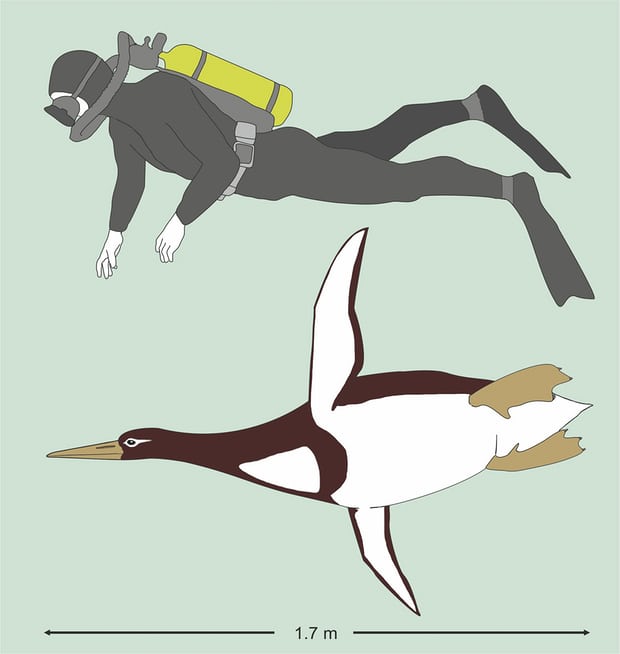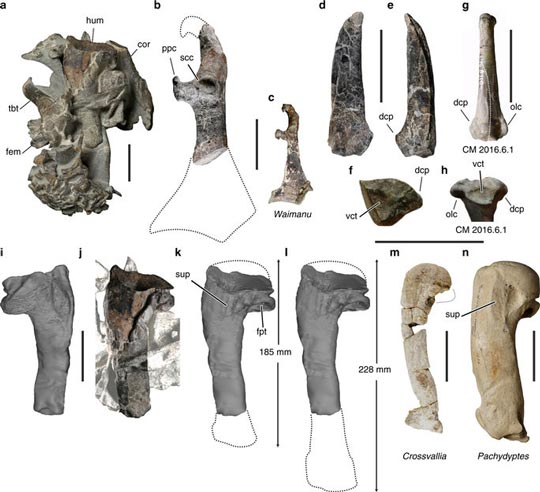Gigantism in Penguins Identified by New Study
Giant Prehistoric Penguins Not Just Once But Several Times
A team of scientists writing in the academic journal “Nature Communications” have identified a new species of giant, prehistoric penguin. This new species, named Kumimanu biceae is not closely related to previously described giant penguins and this suggests that gigantism in penguins evolved several times in the evolution of these birds.
K. biceae was described based on a partial skeleton excavated from the Palaeocene Moeraki Formation at Hampden Beach in the Otago region in New Zealand’s South Island. An accurate size is difficult to establish based on the fragmentary fossil remains, but when swimming with its long beak and flippers extended, this bird could have measured more than two metres in length.
When on the shore, it would have stood around 1.7 metres tall. The new fossil is one of the oldest giant penguins found so far and is clearly outside a clade including the giant Eocene and Oligocene Sphenisciformes, substantiating multiple origins of gigantism in fossil penguins.
Kumimanu biceae Size Comparison

Fragmentary Fossil Material
The partial skeleton represents a single individual and the fossil material consists of a fragment of a left scapula, an incomplete right coracoid, a portion of the sternum, a partial left humerus, incomplete proximal end of left ulna, a right femur, a right tibiotarsus lacking proximal end, a partial synsacrum, three vertebrae and various bone fragments.
The giant penguin’s name comes from Maori myth, kumi was a large, mythical monster and manu means bird. The species or trivial epithet honours Beatrice (Bice) A. Tennyson, the mother of one of the paper’s authors, Alan Tennyson of the Museum of New Zealand Te Papa Tongarewa. It was Alan’s mother who first inspired him to take an interest in natural history. The fossil material is believed to be somewhere between 59.5 and 55.5 million years old.

Picture credit: Nature Communications
Giant Penguin Fossils
The picture above shows the wing and pectoral girdle bones of the new giant penguin. (a) shows the partially prepared concretion with bones in situ, whilst (b) shows the partial right coracoid, the dotted lines indicate the reconstructed outline of the bone. The left coracoid of the prehistoric penguin species Waimanu tuatahi (c) is shown for a size comparison. Pictures (d-f) show the fragmentary end of the left ulna of K. biceae in various views, whilst pictures (g-h) depict a left ulna of an as yet, undescribed new species of penguin from the Waipara Greensand.
A CT image of the surface of the partial left humerus of K. biceae is shown in (i) whilst (j) shows the exposed surface of the bone. Pictures (k-l) show the humerus with minimum (k) and maximum (l) size estimates for the bone based on the partial fossil material. The left humerus of the Palaeocene penguin Crossvallia unienwillia is shown (m). C. unienwillia was one of the largest known prehistoric penguins. The left humerus of another giant penguin, Pachydyptes ponderous from the late Eocene of New Zealand (n) is provided for further comparison. The scale bars in the picture above equate to 5 cm.
The research team conclude that based on the fragmentary fossils, Kumimanu biceae is amongst the largest of the fossil penguins reported so far and since it seems more basal to the family than other giant forms, this suggests that gigantism evolved several times over the long history of penguin evolution.
Visit the Everything Dinosaur website: Everything Dinosaur.

